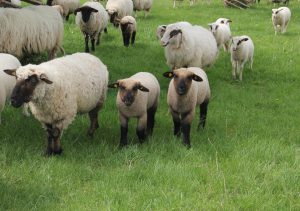Main Content

A 4-H market lamb project is a challenging yet rewarding opportunity for youth members. You will develop important life skills through practicing smart planning and good management techniques. From the beginning of your project to the end, usually between 5-7 months, success will depend on four things: smart selection, strong management, proper nutrition, and excellent showmanship skills. In this post, we will focus on smart selection, the first requirement for success.
Smart Selection Means Smart Planning!
Successful selection of the right market lamb requires several planning steps way before you hand over money to a farmer and head home with your new lamb. Let’s take a look.
- One of the most important considerations you have in selecting a project animal is the length of time you have to finish the lamb. Is your fair in June? July? August? Later? Circle your fair’s weigh-in date on your calendar. Count the number of days you have to reach the desired weight.
- Now consider what the minimum and maximum weights your fair requires at weigh in. You will want to select an animal that has the best chance of reaching the correct amount of fat cover within that weight range by the weigh-in date.
- To help you succeed, look for a lamb that is at least 5 months old by the date of your fair. Avoid lambs that will be younger than 5 months and older than 7 months.
Time For A Little Math.
The next step is to calculate the weight gain necessary before your fair’s weigh-in date. Here’s how to do it.
- With good management, market lambs can be expected to gain an average of 0.6 pounds per day within the last 60-90 days before your fair. Actual rates are 0.4 to 0.8 pounds per day depending on lamb genetics, nutrition and management. How much should your lamb weigh upon purchase?
- Multiply 0.6 pounds times the number of days between purchase and weigh in.
- Subtract this number from your desired finished weight.
- This is the number of pounds your lamb needs to gain.
For example, say you have 80 days to bring your lamb up to the 120-150 pound range. 80 days x 0.6 pounds per day = 48 pounds of gain. Subtract this from your desired finished weight, and you have your desired purchase weight.
Market Lamb 411
Now that you know the approximate age and weight you are shooting for and you are ready to start looking for farms, ask yourself this question first. Do you know what good conformation qualities are necessary to achieve that weight gain? Let’s look at a few definitions that will help you understand muscle, balance, and structural correctness.
- A market lamb is defined as a ewe or wether intended for slaughter that is 4-8 months of age and 90-150 pounds in weight.
- A finished lamb is one that has reached correct weight and body condition to be sold for slaughter with the proper amount of fat cover. The industry accepted fat cover is 0.15 to 0.25 inches.
- Maturity is the time at which growth of lean muscle declines and the adding of fat increases.
- Structural correctness is the lamb’s ability to maintain proper skeletal conformation both as it stands and moves around.
- Balance refers to the overall completeness of the lamb. A well balanced lamb is the proper blend of muscle, structural correctness and eye appeal.
- Frame size refers to the growth potential of the lamb. A large-framed animal will be taller at the top of the shoulder and longer in the neck, body and leg. Large-framed lambs can be expected to finish or have an appropriate amount of fat at 140 to 155 pounds. Larger-framed lambs will mature later, reaching heavier market weight before fat starts accumulating. They are easier to feed in one sense because excessive fat deposition is not a problem. However, if you have a shorter window of time between your purchase date and your fair’s weigh-in date, reaching your desired finished weight might be more difficult.
- Smaller-framed lambs will mature earlier. These animals require less days on feed before beginning to deposit fat. They will, however, have a lighter finishing weight and higher exercise requirements in order to prevent excessive fat deposits. Again, the time you have to raise your lamb will play a role in your choice.
Do you know how to recognize structural correctness, balance, frame size and other important conformation traits when you look at live lambs? Can you communicate knowledgeably with the farmer by knowing the parts of a lamb? If not, plan to learn basics of lamb anatomy and conformation before you start your farm visits. These topics make great 4-H club activities and there are some good examples in the 4-H curriculum “Rams, Lambs & You,” Volume 1. The other sources listed at the end of this blog have excellent lamb judging information as well.
In April we will continue our discussion on the search for “the cream of the flock!”
Sources:
4-H Cooperative Curriculum System Sheep Project Activity Guide, 2000. https://shop4-h.org.
New Jersey 4-H Market Lamb Project Handbook, Rutgers Cooperative Extension, 2002.
Planning for Your 4-H Sheep Project Animal: Lamb Selection, Michigan State University Extension.
Youth Market Lamb Project Guide, NDSU Extension Service, 2009.
4-H/FFA Market Lamb Sheep Project: Selection and Management Checklist, Washington County Extension, Idaho.
Judging Sheep 101, Cindy A. Kinder and Denise Mavencamp, University of Idaho Extension.
By Linda Horner, 4-H Program Coordinator, Cape May County 4-H Youth Development Program